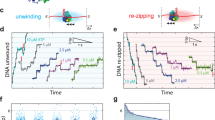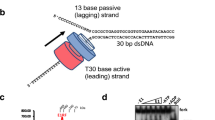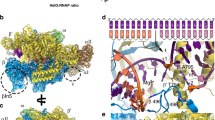Abstract
Helicases translocate along their nucleic acid substrates using the energy of ATP hydrolysis and by changing conformations of their nucleic acid–binding sites. Our goal is to characterize the conformational changes of hepatitis C virus (HCV) helicase at different stages of ATPase cycle and to determine how they lead to translocation. We have reported that ATP binding reduces HCV helicase affinity for nucleic acid. Now we identify the stage of the ATPase cycle responsible for translocation and unwinding. We show that a rapid directional movement occurs upon helicase binding to DNA in the absence of ATP, resulting in opening of several base pairs. We propose that HCV helicase translocates as a Brownian motor with a simple two-stroke cycle. The directional movement step is fueled by single-stranded DNA binding energy while ATP binding allows for a brief period of random movement that prepares the helicase for the next cycle.
This is a preview of subscription content, access via your institution
Access options
Subscribe to this journal
Receive 12 print issues and online access
$189.00 per year
only $15.75 per issue
Buy this article
- Purchase on Springer Link
- Instant access to full article PDF
Prices may be subject to local taxes which are calculated during checkout






Similar content being viewed by others
Accession codes
References
Kolykhalov, A.A., Mihalik, K., Feinstone, S.M. & Rice, C.M. Hepatitis C virus-encoded enzymatic activities and conserved RNA elements in the 3′ nontranslated region are essential for virus replication in vivo. J. Virol. 74, 2046–2051 (2000).
Tai, C.L., Chi, W.K., Chen, D.S. & Hwang, L.H. The helicase activity associated with hepatitis C virus nonstructural protein 3 (NS3). J. Virol. 70, 8477–8484 (1996).
Gwack, Y., Kim, D.W., Han, J.H. & Choe, J. DNA helicase activity of the hepatitis C virus nonstructural protein 3. Eur. J. Biochem. 250, 47–54 (1997).
Frick, D.N., Rypma, R.S., Lam, A.M. & Gu, B. The nonstructural protein 3 protease/helicase requires an intact protease domain to unwind duplex RNA efficiently. J. Biol. Chem. 279, 1269–1280 (2004).
Pang, P.S., Jankowsky, E., Planet, P.J. & Pyle, A.M. The hepatitis C viral NS3 protein is a processive DNA helicase with cofactor enhanced RNA unwinding. EMBO J. 21, 1168–1176 (2002).
Howe, A.Y. et al. A novel recombinant single-chain hepatitis C virus NS3-NS4A protein with improved helicase activity. Protein Sci. 8, 1332–1341 (1999).
Gallinari, P. et al. Modulation of hepatitis C virus NS3 protease and helicase activities through the interaction with NS4A. Biochemistry 38, 5620–5632 (1999).
Heilek, G.M. & Peterson, M.G. A point mutation abolishes the helicase but not the nucleoside triphosphatase activity of hepatitis C virus NS3 protein. J. Virol. 71, 6264–6266 (1997).
Kim, D.W., Gwack, Y., Han, J.H. & Choe, J. Towards defining a minimal functional domain for NTPase and RNA helicase activities of the hepatitis C virus NS3 protein. Virus Res. 49, 17–25 (1997).
Kuang, W.F. et al. Hepatitis C virus NS3 RNA helicase activity is modulated by the two domains of NS3 and NS4A. Biochem. Biophys. Res. Commun. 317, 211–217 (2004).
Levin, M.K., Wang, Y.H. & Patel, S.S. The functional interaction of the hepatitis C virus helicase molecules is responsible for unwinding processivity. J. Biol. Chem. 279, 26005–26012 (2004).
Delagoutte, E. & von Hippel, P.H. Helicase mechanisms and the coupling of helicases within macromolecular machines Part I: Structures and properties of isolated helicases. Q. Rev. Biophys. 35, 431–478 (2002).
von Hippel, P.H. & Delagoutte, E. A general model for nucleic acid helicases and their “coupling” within macromolecular machines. Cell 104, 177–190 (2001).
Lohman, T.M. & Bjornson, K.P. Mechanisms of helicase-catalyzed DNA unwinding. Annu. Rev. Biochem. 65, 169–214 (1996).
Patel, S.S. & Picha, K.M. Structure and function of hexameric helicases. Annu. Rev. Biochem. 69, 651–697 (2000).
Matson, S.W., Bean, D.W. & George, J.W. DNA helicases: enzymes with essential roles in all aspects of DNA metabolism. BioEssays 16, 13–22 (1994).
Tackett, A.J., Morris, P.D., Dennis, R., Goodwin, T.E. & Raney, K.D. Unwinding of unnatural substrates by a DNA helicase. Biochemistry 40, 543–548 (2001).
Kawaoka, J., Jankowsky, E. & Pyle, A.M. Backbone tracking by the SF2 helicase NPH-II. Nat. Struct. Mol. Biol. 11, 526–530 (2004).
Byrd, A.K. & Raney, K.D. Protein displacement by an assembly of helicase molecules aligned along single-stranded DNA. Nat. Struct. Mol. Biol. 11, 531–538 (2004).
Morris, P.D. & Raney, K.D. DNA helicases displace streptavidin from biotin-labeled oligonucleotides. Biochemistry 38, 5164–5171 (1999).
Jankowsky, E., Gross, C.H., Shuman, S. & Pyle, A.M. Active Disruption of an RNA-Protein Interaction by a DExH/D RNA Helicase. Science 291, 121–125 (2001).
Jeong, Y.J., Levin, M.K. & Patel, S.S. The DNA-unwinding mechanism of the ring helicase of bacteriophage T7. Proc. Natl. Acad. Sci. USA 101, 7264–7269 (2004).
Hingorani, M.M. & Patel, S.S. Interactions of bacteriophage T7 DNA primase/helicase protein with single-stranded and double-stranded DNAs. Biochemistry 32, 12478–12487 (1993).
Bujalowski, W. & Jezewska, M.J. Interactions of Escherichia coli primary replicative helicase DnaB protein with single-stranded DNA. The nucleic acid does not wrap around the protein hexamer. Biochemistry 34, 8513–8519 (1995).
Preugschat, F., Averett, D.R., Clarke, B.E. & Porter, D.J.T. A steady-state and pre-steady-state kinetic analysis of the NTPase activity associated with the hepatitis C virus NS3 helicase domain. J. Biol. Chem. 271, 24449–24457 (1996).
Levin, M.K., Gurjar, M.M. & Patel, S.S. ATP binding modulates the nucleic acid affinity of hepatitis C virus helicase. J. Biol. Chem. 278, 23311–23316 (2003).
Levin, M.K. & Patel, S.S. The helicase from hepatitis C virus is active as an oligomer. J. Biol. Chem. 274, 31839–31846 (1999).
Levin, M.K. & Patel, S.S. Helicase from hepatitis C virus, energetics of DNA binding. J. Biol. Chem. 277, 29377–29385 (2002).
Gwack, Y., Kim, D.W., Han, J.H. & Choe, J. Characterization of RNA binding activity and RNA helicase activity of the hepatitis C virus NS3 protein. Biochem. Biophys. Res. Commun. 225, 654–659 (1996).
Leroy, J.L., Kochoyan, M., Huynh-Dinh, T. & Gueron, M. Characterization of base-pair opening in deoxynucleotide duplexes using catalyzed exchange of the imino proton. J. Mol. Biol. 200, 223–238 (1988).
Nonin, S., Leroy, J.L. & Gueron, M. Terminal base pairs of oligodeoxynucleotides: imino proton exchange and fraying. Biochemistry 34, 10652–10659 (1995).
Bonnet, G., Krichevsky, O. & Libchaber, A. Kinetics of conformational fluctuations in DNA hairpin-loops. Proc. Natl. Acad. Sci. USA 95, 8602–8606 (1998).
Singleton, M.R., Dillingham, M.S., Gaudier, M., Kowalczykowski, S.C. & Wigley, D.B. Crystal structure of RecBCD enzyme reveals a machine for processing DNA breaks. Nature 432, 187–193 (2004).
Farah, J.A. & Smith, G.R. The RecBCD enzyme initiation complex for DNA unwinding: enzyme positioning and DNA opening. J. Mol. Biol. 272, 699–715 (1997).
Ali, J.A., Maluf, N.K. & Lohman, T.M. An oligomeric form of E. coli UvrD is required for optimal helicase activity. J. Mol. Biol. 293, 815–834 (1999).
Nanduri, B., Byrd, A.K., Eoff, R.L., Tackett, A.J. & Raney, K.D. Pre-steady-state DNA unwinding by bacteriophage T4 Dda helicase reveals a monomeric molecular motor. Proc. Natl. Acad. Sci. USA 99, 14722–14727 (2002).
Velankar, S.S., Soultanas, P., Dillingham, M.S., Subramanya, H.S. & Wigley, D.B. Crystal structures of complexes of PcrA DNA helicase with DNA substrate indicate an inchworm mechanism. Cell 97, 75–84 (1999).
Kim, J.L. et al. Hepatitis C virus NS3 RNA helicase domain with a bound oligonucleotide: the crystal structure provides insights into the mode of unwinding. Structure 6, 89–100 (1998).
Astumian, R.D. Thermodynamics and kinetics of a Brownian motor. Science 276, 917–922 (1997).
Mogilner, A., Wang, H., Elston, T. & Oster, G. Molecular motors: theory and experiment. In Mathematical Biology (eds. Fall, C., Marland, E., Wagner, J. & Tyson, J.) (Springer, New York, 2001).
Wang, H. & Oster, G. Ratchets, power strokes, and molecular motors. Appl. Phys. A 75, 315–323 (2002).
Ali, J.A. & Lohman, T.M. Kinetic measurement of the step size of DNA unwinding by Escherichia coli UvrD helicase. Science 275, 377–380 (1997).
Dillingham, M.S., Wigley, D.B. & Webb, M.R. Demonstration of unidirectional single-stranded DNA translocation by PcrA helicase: measurement of step size and translocation speed. Biochemistry 39, 205–212 (2000).
Dillingham, M.S., Spies, M. & Kowalczykowski, S.C. RecBCD enzyme is a bipolar DNA helicase. Nature 423, 893–897 (2003).
Kim, D.W., Gwack, Y., Han, J.H. & Choe, J. C-terminal domain of the hepatitis C virus NS3 protein contains an RNA helicase activity. Biochem. Biophys. Res. Commun. 215, 160–166 (1995).
Acknowledgements
We thank C.M. Drain, J.-C. Liao, G. Oster and C. Wolgemuth for comments and discussions. This work was supported by US National Institutes of Health grant GM55310 (S.S.P).
Author information
Authors and Affiliations
Corresponding author
Ethics declarations
Competing interests
The authors declare no competing financial interests.
Rights and permissions
About this article
Cite this article
Levin, M., Gurjar, M. & Patel, S. A Brownian motor mechanism of translocation and strand separation by hepatitis C virus helicase. Nat Struct Mol Biol 12, 429–435 (2005). https://doi.org/10.1038/nsmb920
Received:
Accepted:
Published:
Issue Date:
DOI: https://doi.org/10.1038/nsmb920
This article is cited by
-
Continuous millisecond conformational cycle of a DEAH box helicase reveals control of domain motions by atomic-scale transitions
Communications Biology (2023)
-
The mechanism of DNA unwinding by the eukaryotic replicative helicase
Nature Communications (2019)
-
An overview of HCV molecular biology, replication and immune responses
Virology Journal (2011)
-
Non-hexameric DNA helicases and translocases: mechanisms and regulation
Nature Reviews Molecular Cell Biology (2008)
-
Structural basis for DNA duplex separation by a superfamily-2 helicase
Nature Structural & Molecular Biology (2007)



